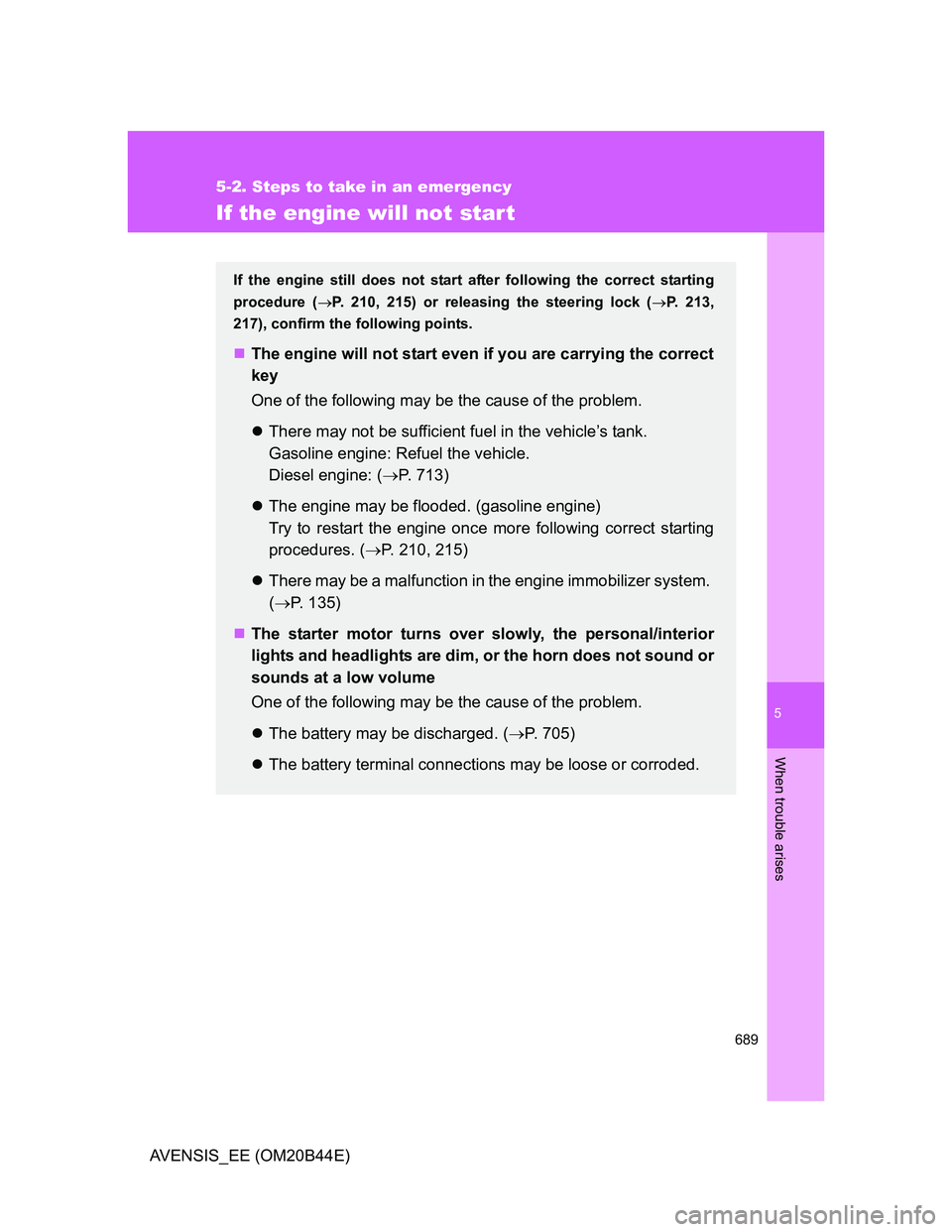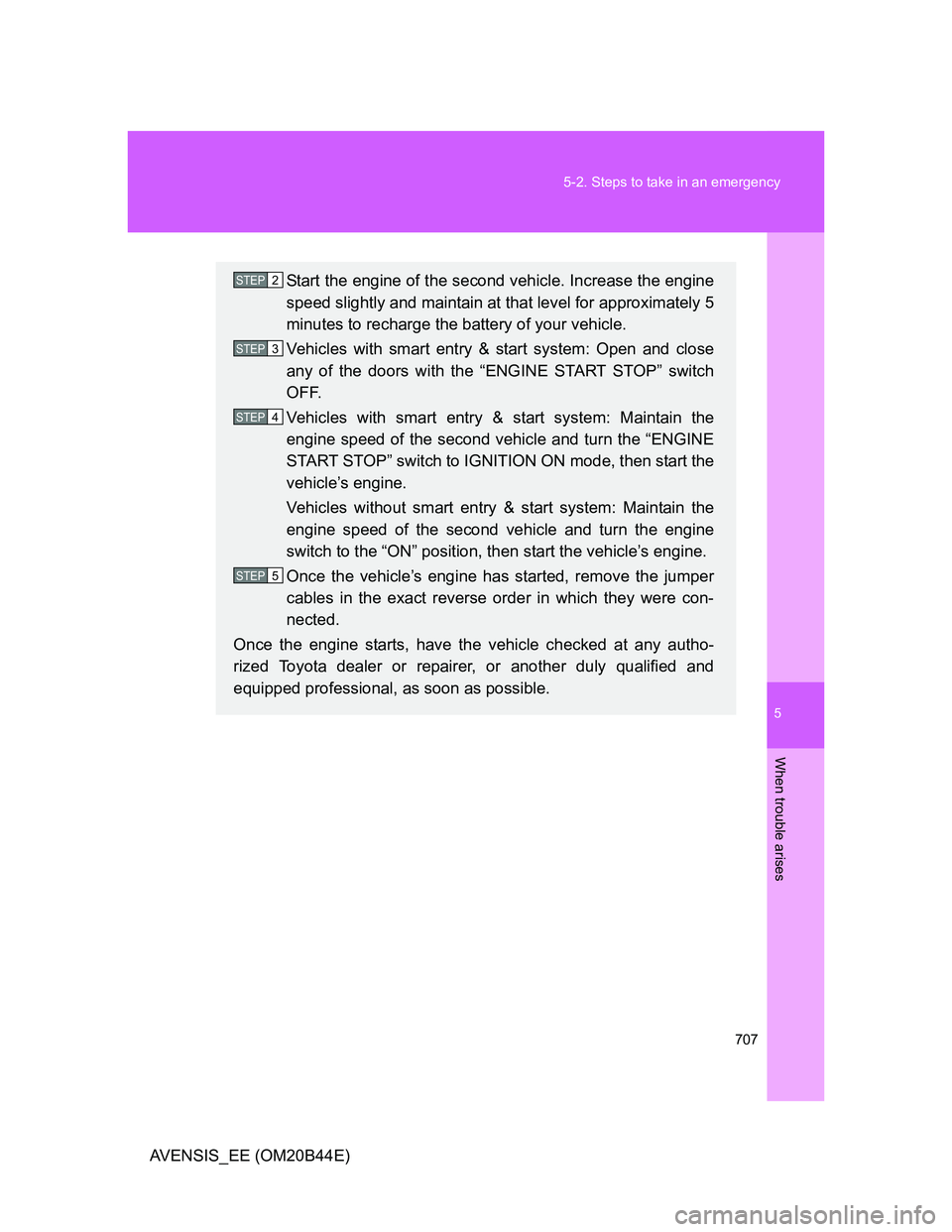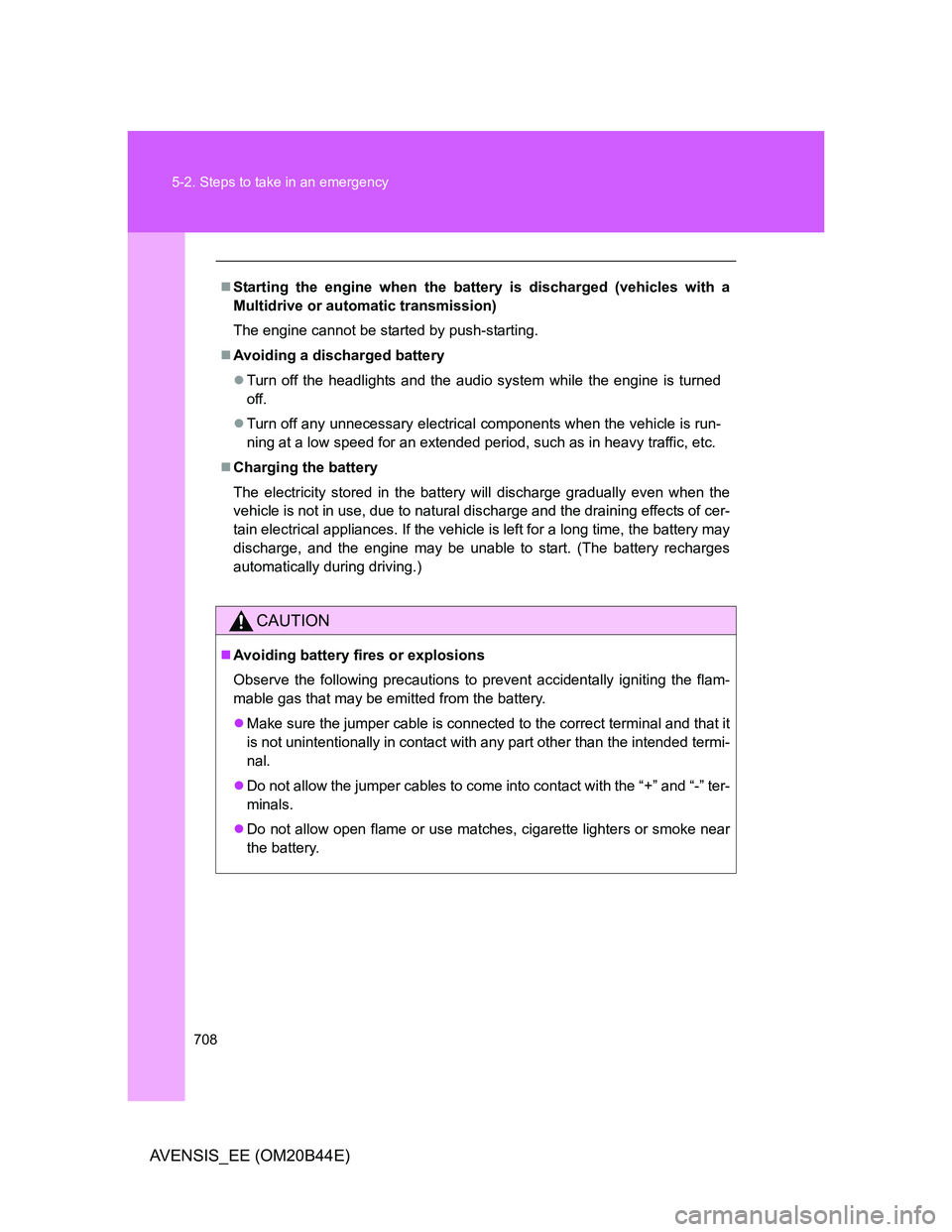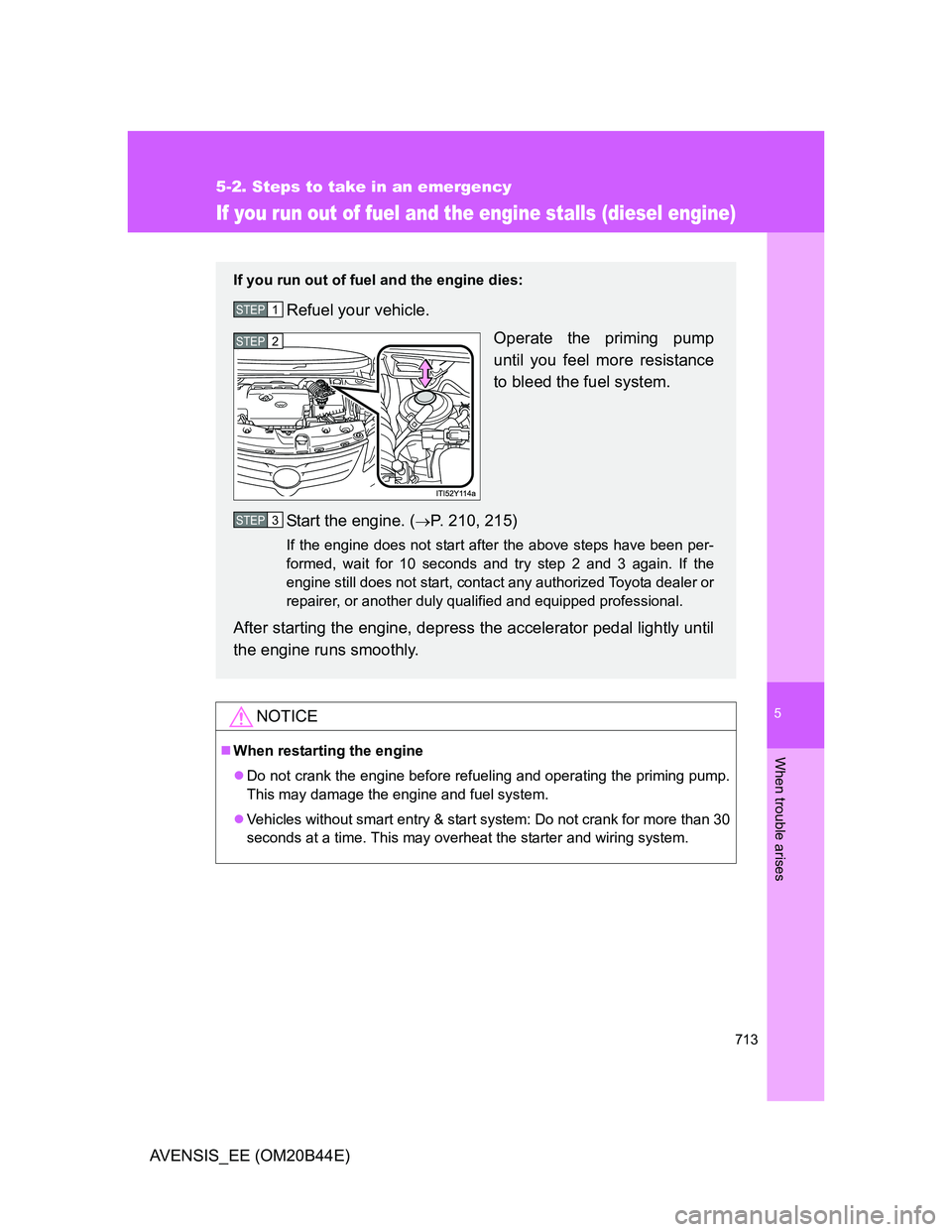Page 689 of 772

5
689
5-2. Steps to take in an emergency
When trouble arises
AVENSIS_EE (OM20B44E)
If the engine will not start
If the engine still does not start after following the correct starting
procedure (P. 210, 215) or releasing the steering lock (P. 213,
217), confirm the following points.
The engine will not start even if you are carrying the correct
key
One of the following may be the cause of the problem.
There may not be sufficient fuel in the vehicle’s tank.
Gasoline engine: Refuel the vehicle.
Diesel engine: (P. 713)
The engine may be flooded. (gasoline engine)
Try to restart the engine once more following correct starting
procedures. (P. 210, 215)
There may be a malfunction in the engine immobilizer system.
(P. 135)
The starter motor turns over slowly, the personal/interior
lights and headlights are dim, or the horn does not sound or
sounds at a low volume
One of the following may be the cause of the problem.
The battery may be discharged. (P. 705)
The battery terminal connections may be loose or corroded.
Page 690 of 772
690 5-2. Steps to take in an emergency
AVENSIS_EE (OM20B44E)
The starter motor does not turn over (vehicles with smart
entry & start system)
The engine starting system may be malfunctioning due to an
electrical problem such as an open circuit or a blown fuse. How-
ever, an interim measure is available to start the engine.
(P. 691)
The starter motor does not turn over, the personal/interior
lights and headlights do not turn on, or the horn does not
sound
One of the following may be the cause of the problem.
One or both of the battery terminals may be disconnected.
The battery may be discharged. (P. 705)
There may be a malfunction in the steering lock system. (vehi-
cles with smart entry & start system)
Contact any authorized Toyota dealer or repairer, or another duly
qualified and equipped professional, if the problem cannot be
repaired, or if repair procedures are unknown.
Page 707 of 772

5
707 5-2. Steps to take in an emergency
When trouble arises
AVENSIS_EE (OM20B44E)
Start the engine of the second vehicle. Increase the engine
speed slightly and maintain at that level for approximately 5
minutes to recharge the battery of your vehicle.
Vehicles with smart entry & start system: Open and close
any of the doors with the “ENGINE START STOP” switch
OFF.
Vehicles with smart entry & start system: Maintain the
engine speed of the second vehicle and turn the “ENGINE
START STOP” switch to IGNITION ON mode, then start the
vehicle’s engine.
Vehicles without smart entry & start system: Maintain the
engine speed of the second vehicle and turn the engine
switch to the “ON” position, then start the vehicle’s engine.
Once the vehicle’s engine has started, remove the jumper
cables in the exact reverse order in which they were con-
nected.
Once the engine starts, have the vehicle checked at any autho-
rized Toyota dealer or repairer, or another duly qualified and
equipped professional, as soon as possible.STEP2
STEP3
STEP4
STEP5
Page 708 of 772

708 5-2. Steps to take in an emergency
AVENSIS_EE (OM20B44E)
Starting the engine when the battery is discharged (vehicles with a
Multidrive or automatic transmission)
The engine cannot be started by push-starting.
Avoiding a discharged battery
Turn off the headlights and the audio system while the engine is turned
off.
Turn off any unnecessary electrical components when the vehicle is run-
ning at a low speed for an extended period, such as in heavy traffic, etc.
Charging the battery
The electricity stored in the battery will discharge gradually even when the
vehicle is not in use, due to natural discharge and the draining effects of cer-
tain electrical appliances. If the vehicle is left for a long time, the battery may
discharge, and the engine may be unable to start. (The battery recharges
automatically during driving.)
CAUTION
Avoiding battery fires or explosions
Observe the following precautions to prevent accidentally igniting the flam-
mable gas that may be emitted from the battery.
Make sure the jumper cable is connected to the correct terminal and that it
is not unintentionally in contact with any part other than the intended termi-
nal.
Do not allow the jumper cables to come into contact with the “+” and “-” ter-
minals.
Do not allow open flame or use matches, cigarette lighters or smoke near
the battery.
Page 713 of 772

5
713
5-2. Steps to take in an emergency
When trouble arises
AVENSIS_EE (OM20B44E)
If you run out of fuel and the engine stalls (diesel engine)
NOTICE
When restarting the engine
Do not crank the engine before refueling and operating the priming pump.
This may damage the engine and fuel system.
Vehicles without smart entry & start system: Do not crank for more than 30
seconds at a time. This may overheat the starter and wiring system.
If you run out of fuel and the engine dies:
Refuel your vehicle.
Operate the priming pump
until you feel more resistance
to bleed the fuel system.
Start the engine. (
P. 210, 215)
If the engine does not start after the above steps have been per-
formed, wait for 10 seconds and try step 2 and 3 again. If the
engine still does not start, contact any authorized Toyota dealer or
repairer, or another duly qualified and equipped professional.
After starting the engine, depress the accelerator pedal lightly until
the engine runs smoothly.
STEP1
STEP2
STEP3
Page 734 of 772
734 6-1. Specifications
AVENSIS_EE (OM20B44E)
Ignition system (gasoline engine)
Electrical system
Spark plug
Make DENSO SC20HR11
Gap 1.1 mm (0.043 in.)
NOTICE
Iridium-tipped spark plugs
Use only iridium-tipped spark plugs. Do not adjust gap when tuning engine.
Battery
Open voltage at 20C (68F): 12.6 12.8 V Fully charged
12.2 12.4 V Half charged
11 . 8 12.0 V Discharged
(Voltage is checked 20 minutes after
the engine and all the lights are
turned off.)
Charging rates 5 A max.
Page 744 of 772
744 6-1. Specifications
AVENSIS_EE (OM20B44E)
Light bulbs
A: H11 halogen bulbs B: D4S discharge bulbs
C: H9 halogen bulbs D: Wedge base bulbs (amber)
E: Wedge base bulbs (clear) F: H16 halogen bulbs
G: Single end bulbs (amber) H: Single end bulbs (clear)
I: Double end bulbs
*: Replace the bulb with one of the same bulb as the original.
Light BulbsWTy p e
ExteriorHeadlights
Low beam
Halogen bulbs
Discharge bulbs
High beam
Halogen bulbs
Discharge bulbs55
35
65
35A
B
C
B
Front turn signal lights 21 D
Front position/daytime running lights
(vehicles with halogen headlights)5/21 E
Front fog lights
Type A
*
Type B*
55
19A
F
Rear turn signal lights 21 G
Back-up light
For sedan
For wagon16
21E
H
Rear fog lights 21 H
License plate lights 5 E
InteriorPersonal/interior lights 8 E
Vanity lights 8 E
Door courtesy lights 5 I
Trunk/luggage compartment light 5 I
Page 746 of 772
746 6-1. Specifications
AVENSIS_EE (OM20B44E)
Fuel tank opening for unleaded gasoline (gasoline engine)
To help prevent incorrect fueling, your Toyota has a fuel tank opening that
only accommodates the special nozzle on unleaded fuel pumps.
If you plan to drive in foreign countries (diesel engine)
Low sulfur diesel fuel may not be available, so please confirm the availability
with your distributor.
If your engine knocks
Consult any authorized Toyota dealer or repairer, or another duly quali-
fied and equipped professional.
You may occasionally notice light knocking for a short time while acceler-
ating or driving uphill. This is normal and there is no need for concern.
1AD-FTV engine with DPF cat-
alytic converter, 2AD-FTV and
2AD-FHV engines
EU area:
Your vehicle must use only diesel
fuel conforming to European
standard EN590.
Except EU area:
Your vehicle must use only diesel
fuel that contains 50 ppm or less
of sulfur and has a cetane num-
ber of 48 or higher.